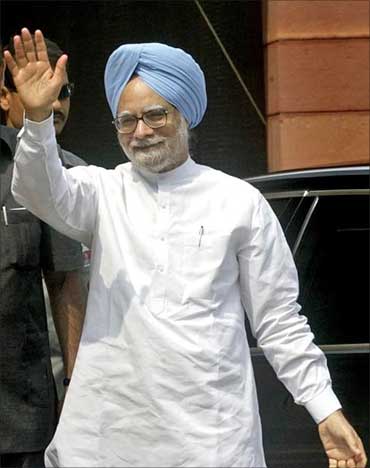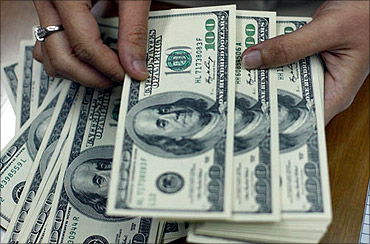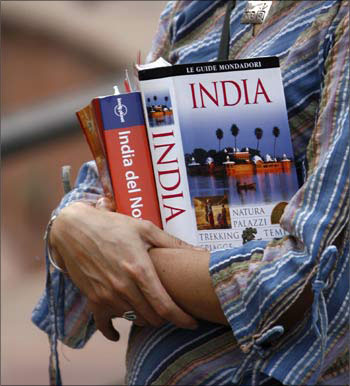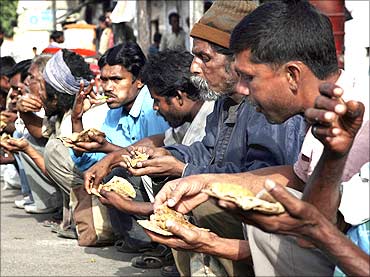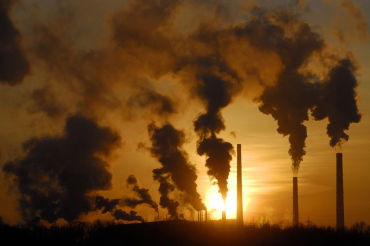 | « Back to article | Print this article |
How 20 years of neoliberalism has ravaged India
Exactly two decades ago, Dr Manmohan Singh, then the finance minister, launched India on a new economic policy course of liberalisation, privatisation and globalisation (LPG).
Singh exploited a short-term foreign exchange crisis to push through a far-reaching long-term agenda. Ironically, on the 20th anniversary of the event, the sleaze associated with neoliberalism, with all its cronyism, criminality and plunder of public wealth, is on full display.
But neoliberalism's diehard supporters strain to deny a link between LPG and scandals.
The crudest of neoliberalism's apologists claim there's no such thing as crony capitalism -- only crony socialism and 'licence-permit raj'. It's as if Harshad Mehta-engineered stock market scams or the Enron scandal of the 1990s, the great telecom scams and public sector selloffs (VSNL, Centaur Hotel, Modern Bakeries, and Balco) of the 2000s or the more recent Posco, Lavasa, ISRO-Antrix, and Krishna-Godavari gas-pricing scandals hadn't happened.
And as if 'regulatory capture' in power, petroleum, insurance and telecom was a mere fiction.
Click NEXT to read on . . .
How 20 years of neoliberalism has ravaged India
Yet other neoliberals are chiding Singh for paying too much attention to 'welfare' and not pushing through second-generation 'reforms', such as dismantling protective labour laws.
A former Leftist claims that neoliberalism is a thing of the past and says the Washington Consensus no longer exists. It was called that because LPG policies were drafted by the United States government with the World Bank and the International Monetary Fund, both headquartered in Washington.
However, the Washington Consensus is very much alive and kicking. It's now being thrust down the throats of European states like Greece and Ireland with the same brutality with which it was imposed on more than 100 developing countries since the late 1980s.
And it's as passionately hated as earlier by its victims, who have to suffer 'austerity' and massive cutbacks in public services even as profligate corporations and banks drenched in speculation get generous bailouts.
This is a good moment to draw up a balance-sheet of neoliberalism's record, and India's embrace two decades ago of a new religion -- GDPism, or worship of rapid growth of the gross domestic product as an end in itself, regardless of social, economic, political and environmental costs.
Click NEXT to read on . . .
How 20 years of neoliberalism has ravaged India
The faith was never officially acknowledged nor even properly named. It was often mis-named 'reform'. 'Reform' means making things better, which GDPism didn't do.
Worse, growth was confused with development. But development isn't growth; it's structural transformation of society.
The primary, if not the sole, merit claimed on behalf of India's neoliberal policies is that they have produced high GDP growth and are therefore successful by definition.
In two decades, India has indeed become an 'emerging' economic power, whose GDP has risen from the 12th rank in the world to the 10th in absolute dollar terms, and from the 9th to the 4th rank in purchasing-power parity -- although in per capita terms India still belongs to the bottom quarter of the world's nations.
Yet, the connection between economic policy and GDP growth isn't straightforward. India's recent growth isn't entirely or largely attributable to the unleashing of the 'animal spirits' of entrepreneurs, which were supposedly locked up earlier under excessive regulation.
Click NEXT to read on . . .
How 20 years of neoliberalism has ravaged India
Indian businessmen have long been adept at bypassing and subverting rules and regulations.
The 1980s also saw high GDP growth in India, although there was no neoliberal domestic regime then. Factors such as high investment and savings rates, and improved infrastructure, also played a big part in speeding up growth in the last 20 years.
However, growth is one thing, distribution quite another. The quality of India's growth is poor because of its great unevenness.
Growth is skewed in favour of services, which now account for over 50 per cent of national income. Agriculture, on which three-fifths of the people depend for livelihood, has declined to under 20 per cent of GDP.
Industry has grown far too slowly to be able to absorb surplus labour from agriculture.
Click NEXT to read on . . .
How 20 years of neoliberalism has ravaged India
India's agrarian crisis is grave. It has driven more than 200,000 farmers to suicide over 12 years, an unprecedented tragedy in world history.
The fruits of growth have accrued largely to the top 10 to 15 per cent of India's population. Growth has depressed employment and failed to raise the incomes of the majority, let alone substantially reduce income poverty.
On the most optimistic official estimate, that of the Tendulkar committee, rural poverty fell from 50.1 per cent in 1993-94 to 41.8 per cent in 2004-05. In urban areas, poverty declined from 32.6 per cent to 25.7 per cent over the same period.
These numbers have been questioned by many capable economists on methodological grounds as far too low. But even assuming they are correct, the decline in poverty was marginal, at best modest.
It still leaves nearly 400 million Indian living at or below an animal level of subsistence, consuming fewer calories than are needed to keep body and soul together. (That's how poverty is officially defined in India.). This is simply unacceptable.
Click NEXT to read on . . .
How 20 years of neoliberalism has ravaged India
So at the end of the two highest-growth decades in recent history, India still has the highest number of dirt-poor people anywhere in the world.
Disturbing as they are, these numbers hide non-income forms of poverty and deprivation, including dispossession from land and other natural resources, extensive ecological destruction, widespread and severe malnutrition, social bondage, unhealthy dependence on powerful exploiters, gender-related poverty, compulsion to drink unsafe water and live in unhygienic conditions, etc.
One-half of India's children are malnourished and two-fifths of its adults have an abnormally low body-mass index. It's no achievement that more Indians have cellphones, whose value is reflected in a rise in GDP, than toilets.
Acute deprivation has a direct impact on the quality of life and ability of people to develop their elementary human potential. Life with dignity, and the capabilities that demarcate human beings from other species, remain impossible for hundreds of millions of Indians.
Arguably, their number has grown over two decades as the natural base of the economy has got degraded and common property resources have been increasingly privatised by predatory capital.
Click NEXT to read on . . .
How 20 years of neoliberalism has ravaged India
Equally sadly, income, wealth and regional disparities, always grotesque, have grown to a point where we have two Indias: a huge cesspool of poverty, stagnation, social backwardness and acute deprivation, which covers much of the country, especially its heartland; and islands of high growth, and moderate and rising social indices in parts of (but by no means the whole of) peninsular India.
Because there is withdrawal of public investment, no correctives are being applied, especially to regional disparities. To this day, only one state (Tamil Nadu) comes close to matching Kerala's 1980s social indices.
Income and wealth disparities are never properly captured in India's kleptocratic society by indicators such as the Gini coefficient, because the rich hide their income and the black economy thrives. But anyone can see that their growth has been explosive.
Obscenely high disparities are socially undesirable in themselves. They also ensure that inequalities in social opportunity will grow, putting the already disadvantaged at further disadvantage.
In India, inequalities strongly cascade at each stage of life: if you are poor, you have less access than the rich to nutrition, healthcare, education, employment, and other social services. You are permanently underprivileged.
Click NEXT to read on . . .
How 20 years of neoliberalism has ravaged India
We are thus allowing GDPism to reshape India into a society which lacks, indeed is structurally incapable of, social cohesion and a genuinely shared sense of nationhood.
An untutored sense of community can only arise from relative equality of life-chances and basic parity in entitlements amongst people.
A notion of common citizenship and shared destiny, which goes beyond participation in electoral processes, cannot develop in a divided society whose chasms will further widen under neoliberalism's ruthlessly inequality-enhancing spell.
All manner of narrow and parochial identity politics, as well as superstition and obscurantism, will thrive in such a society.
It's therefore no surprise that Gujarat, among India's most industrialised and fastest-growing provinces, is also its most communalised state and Hindutva's laboratory, where one-eighth of the population stands disenfranchised.
Click NEXT to read on . . .
How 20 years of neoliberalism has ravaged India
All this means we are paying an exorbitant price for GDPism -- including enormous waste of precious human potential, perpetuation of people's suffering, rising gender inequalities, loss of social cohesion, growth of irrational faith, and a weakening of the foundations of political democracy.
Now add to this the ecological costs of GDPism through the melting of the Himalayan glaciers, loss of prime natural forests, degradation of land, chemicalisation of agriculture, the ravages caused by reckless mining, extensive air and water pollution, poisoning of all our major rivers, overuse of groundwater, loss of priceless biodiversity, and rising greenhouse gas (GHG) emissions.
Driven by a luxury consumption boom and changes in the lifestyles of the top one-tenth of the population under neoliberal policies, India's emissions are growing twice as fast as the rest of the world, aggravating and accelerating climate change.
India is now the world's fourth biggest GHG emitter. Among the world's worst victims of climate change will be Indians themselves.
India couldn't have found a better way of shooting itself in the foot. India and her neighbours have a lot to learn from this 'emerging power' -- including lessons in how not to emerge.
